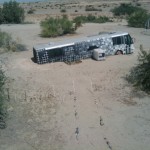customer service
- October 14th, 2010
- Write comment
This is a story about a guy and some toys of his that broke, and how the people who sold these broken toys to him responded.
1st PLACE: ICOM AMERICA – I had a minor problem with my Icom IC-7000 HF/VHF/UHF mobile transciever and, since it was still under warranty, decided to send it in sooner than later. The warranty card said to just send it in with a copy of the original receipt of purchase, showing the date, and a brief description of the problem. That seemed awfully easy, almost too good to be true. So I did. About a week later I called in and was told it had already been repaired and would ship soon. Not only did they fix the problem, but ran a comprehensive test and fixed a few other things, then gave the radio a complete alignment. All I had to do was pay for the shipping back to the service center, about $20 (UPS.) WIN!
2nd PLACE: OUTBACK POWER – I own a lot of Outback stuff; their components are the mainstay of my off-grid power system(s). They’ve always been good about replacing stuff under warranty. When the VFX3648 failed just the other day and I called in about it, the customer rep offered to just send out a complete board replacement kit. That saves us both the hassle of shipping the big, awkward, heavy unit back and forth and saves them a little tech time, and allows me to service my own equipment, which I’m all too happy to do in this case. WIN!
3RD PLACE: T-MOBILE: For the third time now, my G1 phone died. And it’s still under warranty, and insured to the hilt above and beyond that. Nevertheless, I have to submit to being treated like an unwanted visitor on a prison camp before I can get anything done. I have to spend my entire morning negotiating with chatterbots on T-Mobile’s customer-time-wasting phone labyrinth before I finally get the point across that my phone is broken. Then I have to answer a bunch of questions. I feel like I just got pulled over by a cop who doesn’t like men with beards or something, and insists on treating me like a suspect, even though I’m a paying customer. They make me give a lot of information about the phone, which I’m still liable for in case said info is later found to be incorrect. I’m perpetually at their mercy, always on the defensive. I hate it. Once the torture is over, I get an unsolicited call from T-Mobile asking me to participate in a survey about the professionalism of the customer service rep I last spoke to. Guys, your people are doing a great job: it’s your hostile, defensive policy towards customers in need that makes me sick. I wish I had a home version of your phone tree interrogation system, and could make you verify the last four of your Social Security number six times and your mother’s birthplace twice, after making you listen to a minute’s worth of irrelevant drivel while you cling desperately to the line, hoping an actual warm-blooded, sentient being will finally grant you an audience…. Fuck off, I hate you. I can’t wait until my contract with you is over. FAIL.














